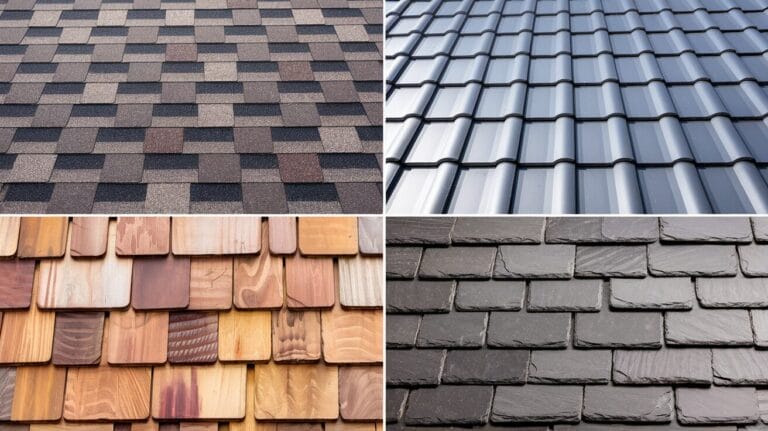
Roof flashing is an essential component of any roofing system. It helps prevent water from seeping into the roof and causing damage to the structure. Installed around roof penetrations and intersections, flashing acts as a barrier against water infiltration and ensures the roof’s longevity and durability. In this blog post, we will guide you through installing roof flashing and highlight some common mistakes to avoid.
How to Install Roof Flashing
Preparing the Roof Surface
Before installing flashing, it is crucial to prepare the roof surface to ensure a proper and secure installation. Start by clearing any debris or loose material from the area where the flashing will be installed. Use a broom or a brush to sweep away dirt, leaves, and other debris. Additionally, inspect the roof surface for any signs of damage or deterioration that may need to be addressed before proceeding with the flashing installation.
Cutting and Measuring the Flashing
Once the roof surface is prepared, it’s time to cut and measure the flashing material. Measure the length and width of the area where the flashing will be installed, allowing for a slight overlap on all sides. Use a metal cutting tool or tin snips to cut the flashing to the appropriate size. Take care to make clean, precise cuts to ensure a proper fit and prevent any gaps where water could penetrate.
Applying Sealant and Attaching the Flashing
Before attaching the flashing, it’s important to apply a generous amount of roofing sealant to the underside of the flashing and the area where it will be installed. This will create a watertight seal and enhance the overall effectiveness of the flashing. Carefully position the flashing over the target area and press it firmly onto the roof surface. Use roofing nails or screws to secure the flashing, ensuring that it is tightly and securely fastened.
Securing the Flashing Edges
To further reinforce the flashing and prevent any potential water infiltration, it is important to secure the edges of the flashing. Apply sealant along the edges of the flashing, creating a tight seal between the flashing and the roof surface. Use roofing nails or screws to secure the edges of the flashing, making sure they are firmly in place. This will not only enhance the structural integrity of the flashing but also prevent any wind uplift that could cause the flashing to come loose.
Inspecting and Testing the Flashing
Once the flashing installation is complete, it is essential to inspect and test the flashing to ensure its effectiveness thoroughly. Carefully examine the flashing for any gaps, cracks, or imperfections that could compromise its ability to prevent water infiltration. Additionally, simulate rain or water flow onto the roof to test the flashing’s performance. Check for any signs of leakage or water seepage. If any issues are identified, address them immediately to maintain the integrity of the flashing and the roof.
Types of Roof Flashing
Metal Flashing
Metal flashing, often made of aluminum or galvanized steel, is a popular and durable option for roof flashing. It offers excellent resistance to corrosion and can withstand various weather conditions. Metal flashing is versatile and can be shaped and customized to fit specific roof profiles and angles.
Rubber Flashing
Rubber flashing, typically made of EPDM (ethylene propylene diene monomer), offers flexibility and superior waterproofing properties. It is especially useful for curved or irregular roof surfaces, as it can easily conform to different shapes and angles. Rubber flashing is also highly resistant to UV rays and can withstand extreme temperatures.
Bitumen Flashing
Bitumen flashing, also known as asphalt flashing, is a cost-effective option commonly used in roof flashing applications. It is made of a blend of bitumen and various modifiers, providing excellent waterproofing capabilities. Bitumen flashing is easy to install and can be heated and molded to fit different roof configurations.
PVC Flashing
PVC flashing is a durable and lightweight option for roof flashing. It is resistant to UV rays, chemicals, and extreme weather conditions, making it suitable for various climates. PVC flashing is available in different colors, allowing for coordination with the roof’s aesthetics.
Lead Flashing
Lead flashing has been used for centuries and is known for its long-lasting performance and malleability. It can be easily shaped and formed to fit complex roof profiles and angles. Lead flashing provides excellent resistance to corrosion and has a high melting point, ensuring its durability over time.
Step-by-Step Installation Process
Gathering the Necessary Tools and Materials
Before starting the installation process, gather all the necessary tools and materials. This may include flashing material, roofing sealant, roofing nails or screws, a measuring tape, a metal cutting tool or tin snips, and a ladder or scaffold for accessing the roof.
Preparing the Area for Installation
Prior to installing the flashing, ensure that the area is clean and free of debris. Sweep or brush away any dirt, leaves, or loose material from the roof surface. If required, repair any damaged or deteriorated sections of the roof before proceeding with the flashing installation.
Aligning and Attaching the Flashing
Align the flashing over the target area, ensuring that it covers the necessary penetration or intersection. Apply a generous amount of roofing sealant to the underside of the flashing and the installation area. Press the flashing firmly onto the roof surface, making sure it adheres securely. Use roofing nails or screws to fasten the flashing, ensuring a tight and secure fit.
Sealing and Securing the Flashing
Apply sealant along the edges of the flashing, creating a waterproof seal between the flashing and the roof surface. Use roofing nails or screws to secure the edges of the flashing, ensuring they are firmly in place. This will prevent any wind uplift and enhance the overall structural integrity of the flashing.
Inspecting and Finalizing the Installation
Thoroughly inspect the installed flashing for any gaps, cracks, or imperfections. Check for proper alignment and ensure that the flashing covers the desired areas adequately. Test the flashing by simulating rain or water flow onto the roof, checking for any signs of leakage or water seepage. Address any issues immediately to ensure the effectiveness of the flashing and protect the roof from potential water damage.
Common Mistakes to Avoid
Using Incorrect Flashing Material
One common mistake is using the wrong type of flashing material for the specific application. Different roof profiles and conditions require different types of flashing. Ensure you choose the appropriate flashing material based on the roof’s needs and consult with a professional if necessary.
Improper Flashing Installation Techniques
Improper installation techniques can compromise the effectiveness of flashing. Take care to follow the manufacturer’s guidelines and recommendations for installation. Use the appropriate tools and materials, and ensure that the flashing is securely fastened and sealed to prevent water infiltration.
Neglecting to Properly Seal the Flashing
A common mistake is failing to apply sufficient sealant when installing flashing. This can lead to water leakage and potential roof damage. Make sure to apply a generous amount of roofing sealant to create a watertight seal between the flashing and the roof surface.
Not Securing Flashing Edges Correctly
Securely fastening the edges of the flashing is crucial to prevent wind uplift and ensure the long-term durability of the installation. Double-check that the edges of the flashing are properly secured using roofing nails or screws, and apply sealant to create a tight seal.
Failing to Inspect and Test the Flashing
Inspecting and testing the flashing after installation is essential to identify any potential issues early on. Regular inspections and testing can help prevent water damage and ensure the flashing is performing as intended. Take the time to check the flashing periodically and address any problems promptly.





